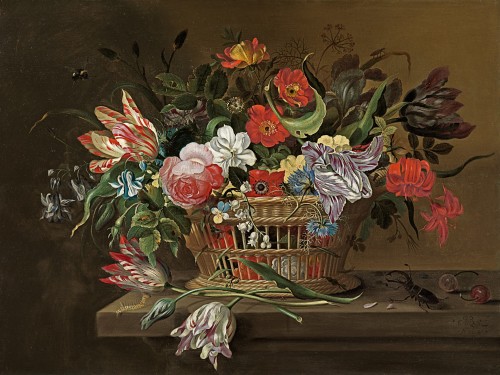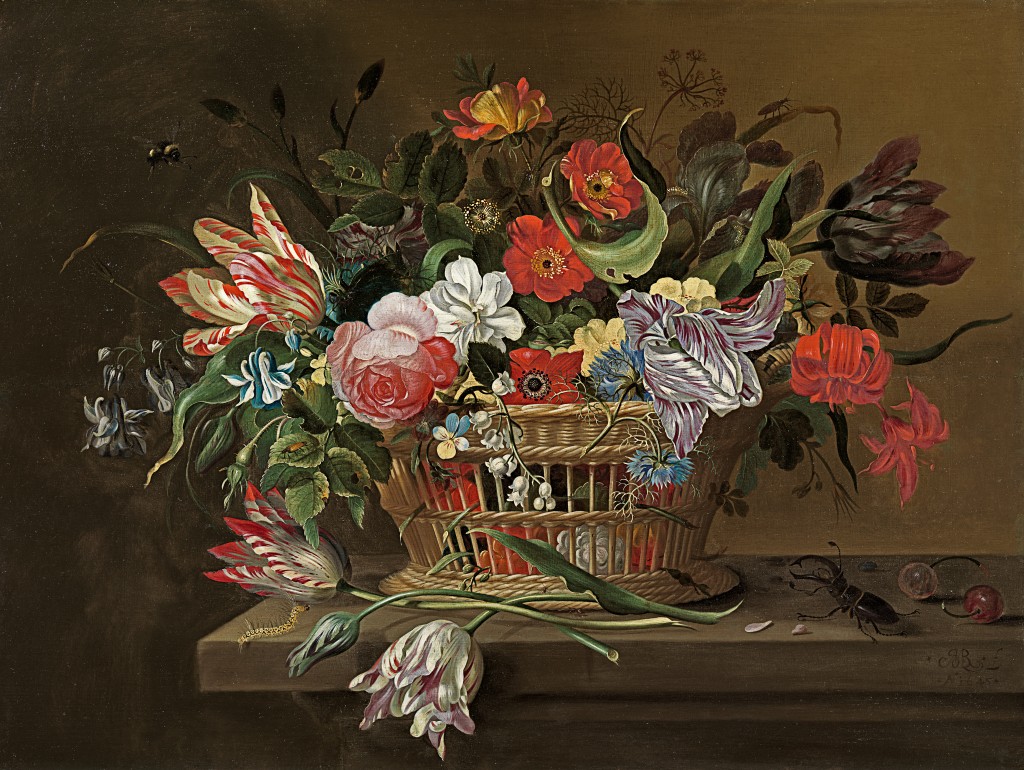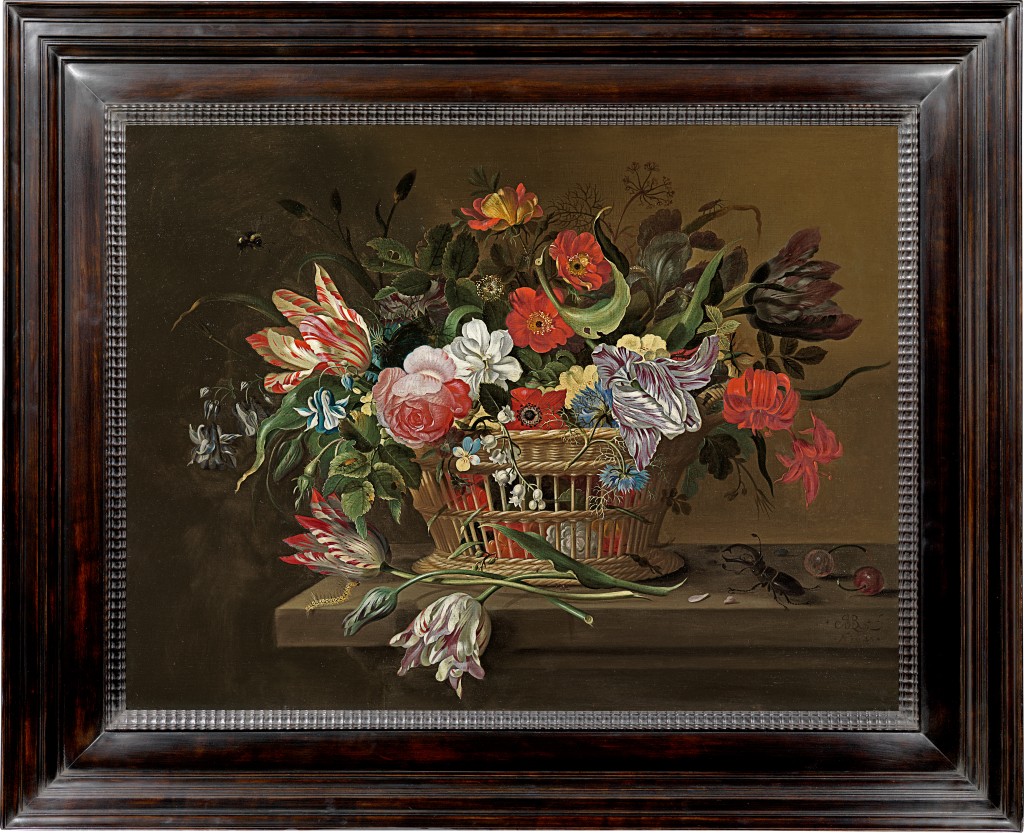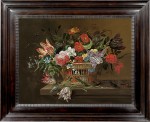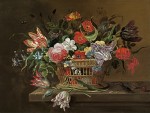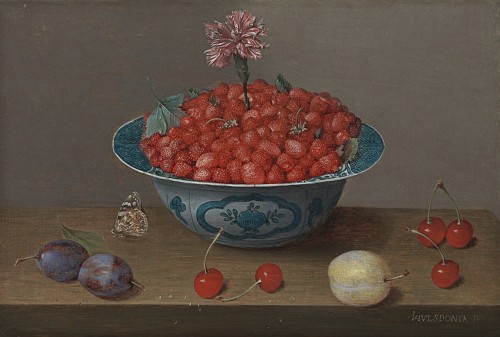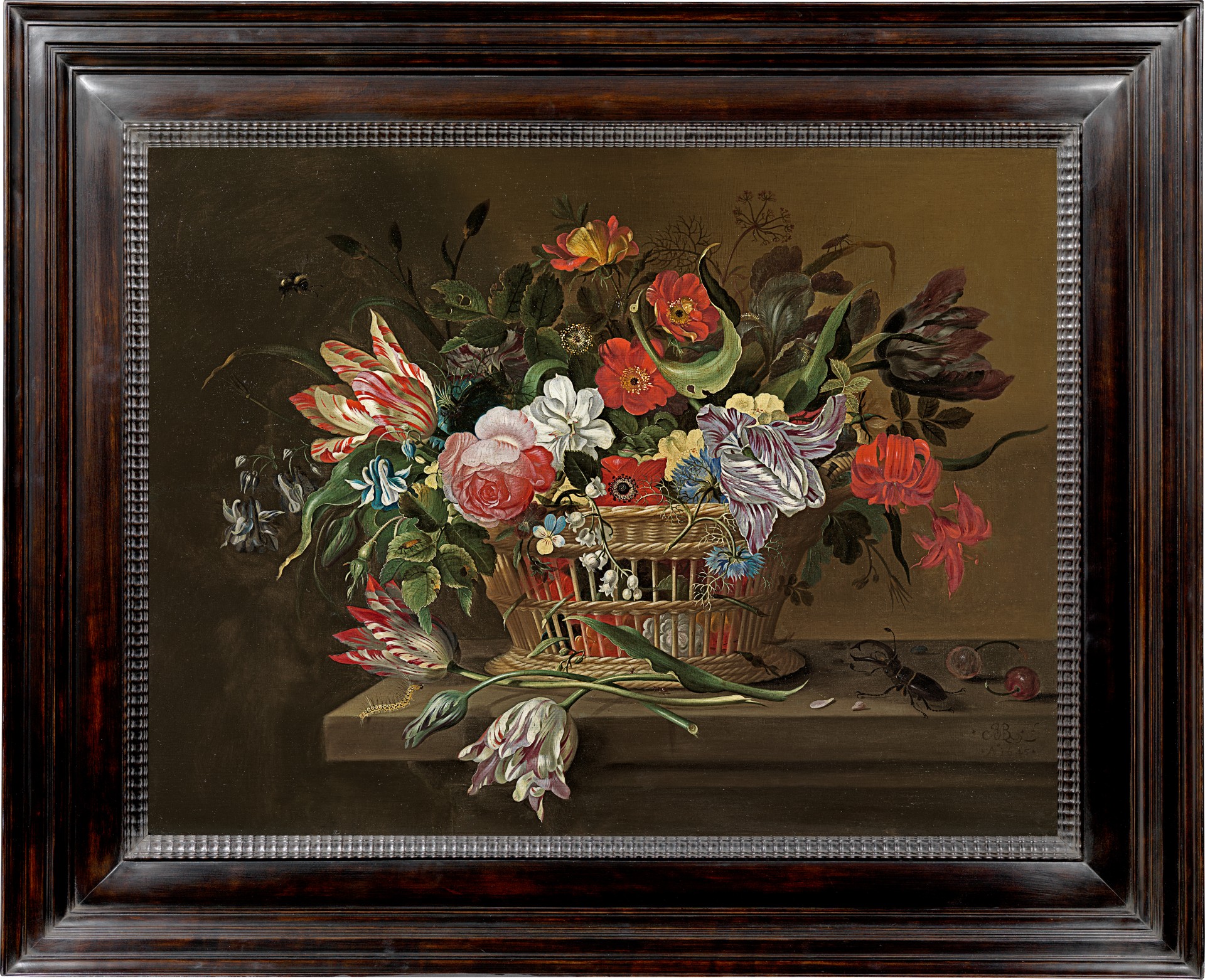JACOB MARREL
Frankenthal 1613/14 - 1681 Frankfurt-am-Main
Ref: CC 113
A still life of tulips, roses, lily-of-the-valley, anemones, martagon lilies and other flowers in a basket
Signed lower right, with the artist’s complex monogram which includes all letter of his name followed by ƒ (for fecit) and dated, under the monogram, .Ao i645.
Oil on panel: 17 ¾ x 23 5/8 in / 45.1 x 60 cm
Frame size: 24 x 30 in / 61 x 76.2 cm
In a black polished seventeenth century style Dutch frame
Provenance:
Medlycott family, Ven House, Milbourne Port, Somerset, before 1957[1];
by descent to Sir Mervyn Medlycott, 9th Bt. (1947-2021), Sandford Orcas Manor, Dorset;
by descent[2]
Jacob Marrel was born in Germany and died there as well. Nevertheless, he can be regarded as belonging to the Dutch school, more specifically, the school of Utrecht. At the age of about 14 he became a pupil of the still-life painter Georg Flegel (1565/66-1638) in Frankfurt am Main. In or shortly before 1632, at about 18 years of age, he came to Utrecht, where he was strongly influenced by painters from what art historian Laurens Bol termed the ‘Bosschaert Dynasty’. It would appear that Marrel was in close contact with Ambrosius Bosschaert the Younger (1609-1645), who was only a few years older than Marrel himself. He stayed in Utrecht for more than fifteen years but must have travelled a lot in the meantime. A vanitas still life from 1637 is inscribed ‘in Francofurth’.[3] Even after having returned to live in Frankfurt around 1650 and staying there more or less permanently for the rest of his life, Marrel must have travelled to the Netherlands quite often. In 1664 he brought his pupil Abraham Mignon (1640-1679) to Utrecht, where the latter started working with Jan Davidsz. de Heem (1606-1684). Apart from being a painter, Jacob Marrel was also active as an art dealer, which may account for his frequent travels and which probably gave him the opportunity to study other artist's works closely on a regular basis. In addition to being an artist in his own right, Marrel was an eager copyist and imitator, apparently absorbing influences like a sponge. After working predominantly in the manner of the Bosschaerts, during the second half of the 1640s, his work started to show a strong influence of de Heem, who was still working in Antwerp at the time. Several excellent copies after works by de Heem signed by Marrell are known.
This flower painting is a fully characteristic work by Jacob Marrel. The flamed tulips are almost signature flowers for the artist; similar tulips can be found in many of his paintings, but also in the tulip books he produced. The stag beetle, which appears in several of Marrel’s paintings, may have been inspired by the work of Georg Flegel, who also depicted this large insect a few times.[4] Jacob Marrel mainly depicted his flowers in vases, but occasionally opted for a basket, like here. Flowers in a basket as a still-life subject started to emerge in the 1610s, by such artists as Ambrosius Bosschaert the Elder (1573-1621) (fig. 1) and Jan Brueghel the Elder (1568-1625) (fig.2). Bosschaert, who worked in Utrecht from 1615 to 1619, inspired his pupil Balthasar van der Ast (1593/94-1657), who was active there from 1615 to 1631, and whose work Marrel must have known well. Van der Ast painted various baskets of flowers (cf. fig. 3). Although van der Ast had moved to Delft in 1631, Marrel was clearly aware of his still lifes from after his Utrecht period, as is borne out by a variation by Marrel of a still life by van der Ast from about 1640 (figs 5 and 6). Marrel’s own first known basket of flowers dates from 1635 (fig. 4). In comparison with Marrel’s numerous still lifes of flowers in a vase, flowers in a basket by him are quite rare. Including the painting discussed here and the one illustrated in figure 4, there do not appear to be not more than five known examples. Two of them are only known from black-and-white illustrations (figs 7 and 8), and all three further examples were probably painted in the 1640s, the third (fig. 9) is not (or no longer) signed, but bears a date of 1648, which appears to be original.[5]
The signature of the present painting is one that Marrel appears to have used specifically in the 1640s. It includes all the letters of his name: JACOBMREL.[6] With the same date, 1645, it appears on two pages of Marrel’s tulip book in the Rijksmuseum, Amsterdam (figs 10 and 11).[7] It also appears on several of Marrel’s paintings from the 1640s, such as on a still life of flowers and some fruit from 1647 (fig. 12) and on an undated example in the Frans Halsmuseum in Haarlem, which, due to the misinterpreted signature, was previously attributed to Hans Bollongier (fig. 13).
While Jacob Marrel produced many tulip drawings for tulip books, he does not appear to have used those as models for his paintings. And while the vast majority of his flower paintings include tulips, he hardly ever seems to have repeated a tulip in more than one painting, which was common practice for many of his contemporaries, such as Balthasar van der Ast. While the tulips in the tulip books are all adorned with (often fancy) names, none of the tulips in the oil paintings can be identified as such a specific specimen, as no flower is identical to an example in a tulip book. In many of his tulip drawings, Marrel introduced bijwerk, additional motifs. In a sheet from 1637, for instance, Marrel introduced a stag beetle, as he did in this painting (fig. 14), and in another a couple of cherries, one of which is virtually identical to one of the cherries in the painting discussed here (fig. 15).
The iconography of this painting is probably not very profound. There is the usual vanitas connotation of the flowers themselves, which bloom only briefly and wither soon, which can remind the viewer of his own mortality. The sense of oncoming decay can also be found in some of the leaves that have been gnawed by insects and others with edges that already have gone brown. But above all, this is a highly charming arrangement of beautiful flowers, for the viewer to enjoy.
Fred G Meijer
1 Ambrosius Bosschaert I, signed with monogram and dated 1614, oil on copper 28.6 x 38.1 cm. Los Angeles, J. Paul Getty Museum
2 Jan Brueghel I, signed and dated 1615, oil on panel, 55.2 x 89.1 cm. Washington DC, National Gallery of Art
3 Balthasar van der Ast, signed, oil on canvas, 42 x 62 cm. Stockholm, Nationalmuseum
4 Jacob Marrel, signed and dated 1635, oil on panel, 31.7 x 40.6 cm. Art market, 1996
5 Jacob Marrel, signed, oil on panel, 49 x 74 cm. Art market, 2023
6 Balthasar van der Ast, signed, oil on panel, 55 x 65 cm. Art market, 1978[8]
7 Jacob Marrel, oil on panel, 47 x 73.3 cm. Art market, 1991
8 Jacob Marrel, oil on panel, 49.5 x 85 cm. Art market, 1961
9 Jacob Marrel, dated (?) 1648, oil on panel, 54.2 x 71.5 cm. Art market, 2013
10 Jacob Marrel, signed and dated 1645, page from a tulip book, 265 x 335 mm. Amsterdam, Rijksmuseum, inv. no. RP-T-1950-266-43-2
11 Jacob Marrel, signed and dated 1645, page from a tulip book, 265 x 335 mm. Amsterdam, Rijksmuseum, inv. no. RP-T-1950-266-43-1
12 Jacob Marrel, signed and dated 1647, oil on panel, 74 x 60 cm. Art market, 1993
13 Jacob Marrel, signed, oil on panel, 26.5 x 32.2 cm. Haarlem, Frans Halsmuseum
14 Jacob Marrel, signed and dated 1637, page from a tulip book, 265 x 335 mm. Amsterdam, Rijksmuseum, inv. no. RP-T-1950-266-25-2
15 Jacob Marrel, signed and dated 1637, page from a tulip book, 265 x 335 mm. Amsterdam, Rijksmuseum, inv. no. RP-T-1950-266-30-1
NOTES
[1] According to an inscription on the reverse of the nineteenth century frame, it was hung in the study, opposite the window.
[2] This painting was in the collection of the Medlycott family at Ven House, Milborne Port, Somerset certainly before 1957 and probably since at least the nineteenth century. The handsome red brick and stone Ven House was built 1698-1700 and enlarged by James Medlycott c.1725-30. Ven was sold by Sir Hubert Medlycott in 1957. The painting by Marrel subsequently hung at the Medlycotts’ seat of Sandford Orcas Manor, Dorset, about six miles from Ven. Sandford Orcas Manor was built c.1550 for Edward Knoyle and passed into the Hutchings family in 1736. In 1914 it was inherited by a cousin of Hubert Hutchings, Sir Hubert Medlycott, 6th Bt. Sandford Orcas was sold after the death of Sir Mervyn Medlycott, 9th Bt. (1947-2021) and the painting has descended in his family (with thanks for this note to Susan Morris).
[3] Oil on canvas, 92 x 80 cm, signed and dated 1637, Karlsruhe, Staatliche Kunsthalle, inv. no. 2586.
[4] As observed by L.J. Bol, Goede Onbekenden, 1982, p. 65.
[5] When the painting first appeared in 2005, it sported a van der Ast signature above the date 1648.
[6] The A and B being prominent have led to incorrect attributions of work with this signature to Ambrosius Bosschaert (II) or Hans Bollongier (fig. 13).
[7] The correct interpretation of the signature was first published by Ingvar Bergström, ‘Een tulpenboek geschilderd door Jacob Marrel’, Tableau VII, no. 2, 1984, pp. 40 and 46 (fig. D).
[8] In this illustration, a few centimetres of the panel are missing to the right.

